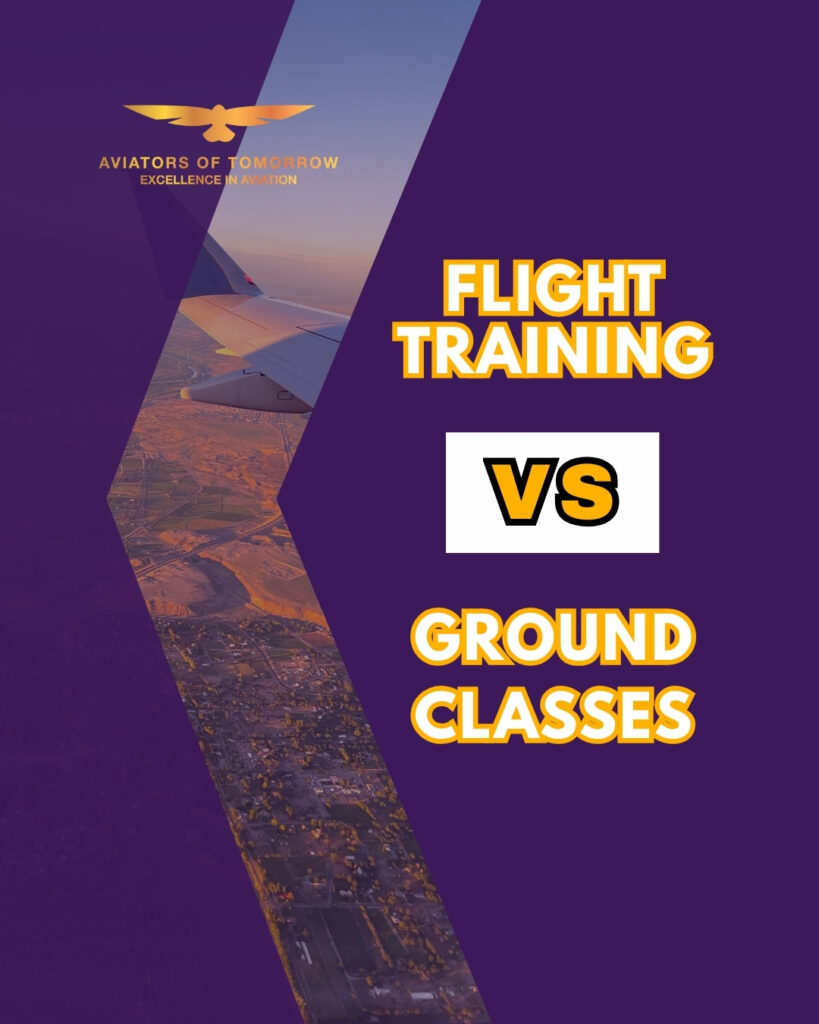Becoming a pilot is a dream that excites thousands of students in India every year. The idea of flying an aircraft and seeing the world from above is thrilling, but the journey to the cockpit is not as simple as it looks. Every aspiring aviator must first pass through DGCA ground classes and later move on to flight training.
For beginners, these two stages can sound confusing. Do you really need ground classes if your ultimate goal is flying? How are they different from actual flight training? The truth is, both are equally important, and together they shape you into a safe, skilled, and responsible pilot.
In this blog, we’ll break down the key differences between DGCA ground classes and pilot training, so you know exactly what to expect on your pilot journey.

Table of Contents
What Are DGCA Ground Classes?
DGCA ground classes are the foundation of your pilot training. Conducted under the supervision of the Directorate General of Civil Aviation (DGCA), these classes are designed to prepare you for the mandatory theory exams.
During this phase, you’ll dive deep into:
- Air Navigation: Learning how to calculate routes, distances, and timings.
- Air Regulations: Understanding aviation laws, safety rules, and air traffic protocols.
- Meteorology: Studying weather patterns, storms, and their effect on flights.
- Technical General: Gaining knowledge about aircraft engines, instruments, and systems.
- Radio Telephony (RTR): Training in effective communication with air traffic control.
Think of it this way: DGCA ground classes are like the classroom lessons before you drive a car. You wouldn’t hit the highway without understanding road rules. The same logic applies to aviation.
For more information about DGCA Ground classes you may read our blog “DGCA Ground Classes: Complete Guide“
What Is Flight Training?
Once you clear your DGCA exams, the next step is flight training. This is where the real magic begins; you move from theory to practice. Flight training involves getting inside an actual aircraft (or simulator) and learning how to fly under the guidance of a certified flight instructor.
Flight training covers:
- Basic flying skills: Take-off, landing, and navigation.
- Instrument flying: Learning to fly using cockpit instruments.
- Night flying: Handling aircraft during low visibility conditions.
- Cross-country flights: Long-distance flying experience.
- Emergency procedures: Learning to handle unexpected situations safely.
This stage is measured in flying hours. For a Commercial Pilot License (CPL) in India, you need at least 200 hours of flight training. These hours are logged carefully and become part of your official pilot record.
For more information about pilot training, you may read our blog “Complete Guide to Pilot Training in 2025“
Key Differences Between DGCA Ground Classes and Flight Training
Aspect | DGCA Ground Classes | Flight Training |
| Focus | Theoretical knowledge | Practical flying skill |
| Subjects | Navigation, Meteorology, Air Regulations, Technical, RTR | Take-offs, Landings, Navigation, Emergency Handling |
| Mode | Classroom or online learning | Actual aircraft & simulators |
| Duration | 3–6 months (varies by institute) | 200+ flying hours (6–18 months depending on pace) |
| Outcome | Clearing DGCA written exams | Earning your pilot licence (CPL/PPL) |
If you feel all this information is getting a bit hard to understand, don’t worry, you can simply fill out the form below. Our team will explain everything to you in a clear and easy way so you know exactly how to start your pilot journey.
Stand a chance to win 100% scholarship & start training with India’s trusted aviation institute.
Apply & Check Eligibility
Apply Now!Why Both Are Essential for Pilot Training
Some students believe they can skip ground classes or rush through them, but that’s a big mistake. Here’s why both are equally vital:
- Safety First: Aviation is unforgiving of mistakes. Ground classes ensure you understand safety rules before flying.
- Confidence in the Cockpit: Knowledge of weather, navigation, and aircraft systems makes you confident during flight training.
- Regulatory Requirement: DGCA mandates clearing theory exams before starting full-fledged flight training.
- Career Growth: Airlines value pilots with strong theoretical knowledge and excellent flying skills.
Duration and Cost Comparison
- DGCA Ground Classes: Usually 3–6 months, depending on your schedule. Fees can range from ₹2 to ₹3 lakhs for the full course.
- Flight Training: Takes around 12–18 months to complete 200 hours of flying. Costs can vary widely, between ₹40 lakhs to ₹60 lakhs, depending on whether you train in India or abroad.
Yes, it’s an investment. But remember, aviation is a high-reward career. Pilots are among the most respected and well-paid professionals in the world.
How to Choose Between Institutes for DGCA Ground Classes and Flight Training
Choosing the right institute can make or break your career. Here’s what to look for:
For DGCA Ground Classes:
- Experienced faculty with aviation backgrounds.
- Updated study material aligned with DGCA exam patterns.
- Mock tests and doubt-clearing sessions.
- Online/offline flexibility.
For Flight Training:
- DGCA-approved flying school.
- Fleet of modern, well-maintained aircraft.
- Qualified instructors with real-world flying experience.
- Good student-to-instructor ratio.
- Transparent flying hour logging system.
A Pilot’s Journey
Ask any professional pilot, and they’ll tell you: the journey starts in the classroom but finds its meaning in the cockpit. Many students initially feel restless during DGCA ground classes, wanting to skip straight to flying. But later, when they encounter turbulence or tricky weather, they realize how valuable that classroom knowledge was.
Flight training, on the other hand, is where dreams take flight. The first time you sit in the cockpit, take off, and look down at the world, you’ll know why you invested so much effort. Both stages are challenging, but together they make the journey truly rewarding.
Conclusion
So, DGCA ground classes vs flight training, what’s the difference? Ground classes give you the theoretical backbone, while flight training gives you the practical wings. One teaches you how to think like a pilot, and the other teaches you how to act like one.
If you’re serious about becoming a pilot, embrace both with equal dedication. Remember, your dream of flying high starts on the ground but only takes shape in the skies. The sky is waiting — are you ready to begin your pilot training journey?
Fill out the form below and let us guide you toward starting your pilot journey the right way.
Stand a chance to win 100% scholarship & start training with India’s trusted aviation institute.
Apply & Check Eligibility
Apply Now!
